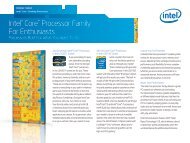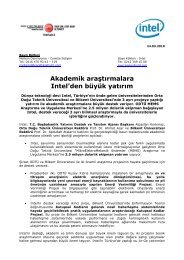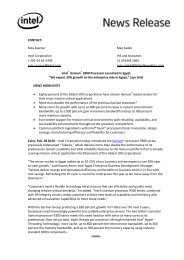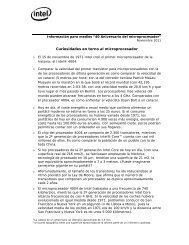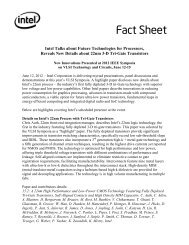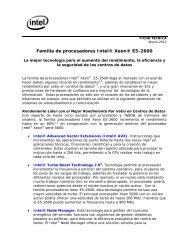Intel Silicon Photonics Press Release FINAL FINAL FINAL.pdf
Intel Silicon Photonics Press Release FINAL FINAL FINAL.pdf
Intel Silicon Photonics Press Release FINAL FINAL FINAL.pdf
You also want an ePaper? Increase the reach of your titles
YUMPU automatically turns print PDFs into web optimized ePapers that Google loves.
CONTACT: Mayar Naguib May Sadek<br />
<strong>Intel</strong> Corporation Hill and Knowlton<br />
+ 202-24-61-5449 +2 014444 2065<br />
Mayar.naguib@intel.com may.sadek@hillandknowlton.com<br />
<strong>Intel</strong> Milestone Confirms Light Beams Can Replace Electronic Signals<br />
For Future Computers<br />
<strong>Intel</strong> Creates World’s First End-to-End <strong>Silicon</strong> <strong>Photonics</strong> Connection with Integrated<br />
Lasers; Could Revolutionize Computer Design, Dramatically Increase Performance, Save<br />
Energy<br />
NEWS HIGHLIGHTS<br />
<strong>Intel</strong> Labs has created the world’s first silicon-based optical data connection with integrated<br />
lasers using Hybrid <strong>Silicon</strong> Laser technology.<br />
The experimental chip can move data at 50 billion bits per second (50Gbps). Researchers are<br />
now pressing on to demonstrate even faster speeds.<br />
The availability of low-cost, high-speed optical communications based on this technology<br />
could allow computer makers to completely rethink traditional system design from netbooks to<br />
supercomputers.<br />
Businesses with server farms or datacenters could eliminate performance bottlenecks while<br />
saving significant operational costs in space and energy, replacing many cables with one<br />
optical fiber.<br />
Cairo, Egypt, July 28, 2010 – <strong>Intel</strong> Corporation today announced an important advance in the<br />
quest to use light beams to replace the use of electrons to carry data in and around computers.<br />
The company has developed a research prototype representing the world‟s first silicon-based<br />
optical data connection with integrated lasers. The link can move data over longer distances and<br />
many times faster than today‟s copper technology; up to 50 gigabits of data per second. This is<br />
the equivalent of an entire HD movie being transmitted each second.<br />
Today computer components are connected to each other using copper cables or traces on<br />
circuit boards. Due to the signal degradation that comes with using metals such as copper to<br />
transmit data, these cables have a limited maximum length. This limits the design of computers,<br />
forcing processors, memory and other components to be placed just inches from each other.<br />
Today‟s research achievement is another step toward replacing these connections with extremely<br />
thin and light optical fibers that can transfer much more data over far longer distances, radically<br />
-- more --
changing the way computers of the future are designed and altering the way the datacenter of<br />
tomorrow is architected.<br />
<strong>Silicon</strong> photonics will have applications across the computing industry. For example, at these<br />
data rates one could imagine a wall-sized 3D display for home entertainment and<br />
videoconferencing with a resolution so high that the actors or family members appear to be in the<br />
room with you. Tomorrow‟s datacenter or supercomputer may see components spread<br />
throughout a building or even an entire campus, communicating with each other at high speed, as<br />
opposed to being confined by heavy copper cables with limited capacity and reach. This will<br />
allow datacenter users, such as a search engine company, cloud computing provider or financial<br />
datacenter, to increase performance, capabilities and save significant costs in space and energy,<br />
or help scientists build more powerful supercomputers to solve the world‟s biggest problems.<br />
Justin Rattner, <strong>Intel</strong> chief technology officer and director of <strong>Intel</strong> Labs, demonstrated the<br />
<strong>Silicon</strong> <strong>Photonics</strong> Link at the Integrated <strong>Photonics</strong> Research conference in Monterey, Calif. The<br />
50Gbps link is akin to a “concept vehicle” that allows <strong>Intel</strong> researchers to test new ideas and<br />
continue the company‟s quest to develop technologies that transmit data using over optical<br />
fibers, using light beams from low cost and easy to make silicon, instead of costly and hard to<br />
make devices using exotic materials like gallium arsenide. While telecommunications and other<br />
applications already use lasers to transmit information, current technologies are too expensive<br />
and bulky to be used for PC applications.<br />
“This achievement of the world‟s first 50Gbps silicon photonics link with integrated<br />
hybrid silicon lasers marks a significant achievement in our long term vision of „siliconizing‟<br />
photonics and bringing high bandwidth, low cost optical communications in and around future<br />
PCs, servers, and consumer devices” Rattner said.<br />
The 50Gbps <strong>Silicon</strong> <strong>Photonics</strong> Link prototype is the result of a multi-year silicon<br />
photonics research agenda, which included numerous “world firsts.” It is composed of a silicon<br />
transmitter and a receiver chip, each integrating all the necessary building blocks from previous<br />
<strong>Intel</strong> breakthroughs including the first Hybrid <strong>Silicon</strong> Laser co-developed with the University of<br />
California at Santa Barbara in 2006 as well as high-speed optical modulators and photodetectors<br />
announced in 2007.<br />
The transmitter chip is composed of four such lasers, whose light beams each travel into<br />
an optical modulator that encodes data onto them at 12.5Gbps. The four beams are then<br />
combined and output to a single optical fiber for a total data rate of 50Gbps. At the other end of
<strong>Intel</strong>/Page 3<br />
the link, the receiver chip separates the four optical beams and directs them into photo detectors,<br />
which convert data back into electrical signals. Both chips are assembled using low-cost<br />
manufacturing techniques familiar to the semiconductor industry. <strong>Intel</strong> researchers are already<br />
working to increase the data rate by scaling the modulator speed as well as increase the number<br />
of lasers per chip, providing a path to future terabit/s optical links – rates fast enough to transfer<br />
a copy of the entire contents of a typical laptop in one second.<br />
This research is separate from <strong>Intel</strong>‟s Light Peak technology, though both are components<br />
of <strong>Intel</strong>‟s overall I/O strategy. Light Peak is an effort to bring a multi-protocol 10Gbps optical<br />
connection to <strong>Intel</strong> client platforms for nearer-term applications. <strong>Silicon</strong> <strong>Photonics</strong> research aims<br />
to use silicon integration to bring dramatic cost reductions, reach tera-scale data rates, and bring<br />
optical communications to an even broader set of high-volume applications. Today‟s<br />
achievement brings <strong>Intel</strong> a significant step closer to that goal.<br />
About <strong>Intel</strong><br />
<strong>Intel</strong> (NASDAQ: INTC) is a world leader in computing innovation. The company designs<br />
and builds the essential technologies that serve as the foundation for the world‟s computing<br />
devices. Additional information about <strong>Intel</strong> is available at www.intel.com/pressroom and<br />
blogs.intel.com.<br />
– 30 –<br />
<strong>Intel</strong> and the <strong>Intel</strong> logo are trademarks of <strong>Intel</strong> Corporation in the United States and other countries.<br />
* Other names and brands may be claimed as the property of others.


